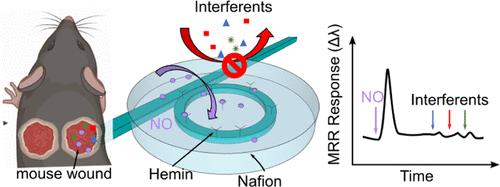Our official English website, www.x-mol.net, welcomes your
feedback! (Note: you will need to create a separate account there.)
Real-Time In Vivo Sensing of Nitric Oxide Using Photonic Microring Resonators
ACS Sensors ( IF 8.2 ) Pub Date : 2022-08-08 , DOI: 10.1021/acssensors.2c00756 Sakib Hassan 1 , Christian C Schreib 2 , Xuan Zhao 3 , Guillaume Duret 1 , Daniel S Roman 4 , Vishnu Nair 5 , Tzahi Cohen-Karni 4 , Omid Veiseh 2 , Jacob T Robinson 1, 2, 5
ACS Sensors ( IF 8.2 ) Pub Date : 2022-08-08 , DOI: 10.1021/acssensors.2c00756 Sakib Hassan 1 , Christian C Schreib 2 , Xuan Zhao 3 , Guillaume Duret 1 , Daniel S Roman 4 , Vishnu Nair 5 , Tzahi Cohen-Karni 4 , Omid Veiseh 2 , Jacob T Robinson 1, 2, 5
Affiliation

|
Real-time in vivo detection of biomarkers, particularly nitric oxide (NO), is of utmost importance for critical healthcare monitoring, therapeutic dosing, and fundamental understanding of NO’s role in regulating many physiological processes. However, detection of NO in a biological medium is challenging due to its short lifetime and low concentration. Here, we demonstrate for the first time that photonic microring resonators (MRRs) can provide real-time, direct, and in vivo detection of NO in a mouse wound model. The MRR encodes the NO concentration information into its transfer function in the form of a resonance wavelength shift. We show that these functionalized MRRs, fabricated using complementary metal oxide semiconductor (CMOS) compatible processes, can achieve sensitive detection of NO (sub-μM) with excellent specificity and no apparent performance degradation for more than 24 h of operation in biological medium. With alternative functionalizations, this compact lab-on-chip optical sensing platform could support real-time in vivo detection of myriad of biochemical species.
中文翻译:

使用光子微环谐振器实时体内检测一氧化氮
实时体内检测生物标志物,尤其是一氧化氮 (NO),对于关键的医疗保健监测、治疗剂量以及对 NO 在调节许多生理过程中的作用的基本理解至关重要。然而,由于其短寿命和低浓度,在生物介质中检测 NO 具有挑战性。在这里,我们首次证明光子微环谐振器 (MRR) 可以提供实时、直接和体内在小鼠伤口模型中检测 NO。MRR 以共振波长偏移的形式将 NO 浓度信息编码到其传递函数中。我们表明,这些使用互补金属氧化物半导体 (CMOS) 兼容工艺制造的功能化 MRR 可以实现对 NO(亚 μM)的灵敏检测,具有出色的特异性,并且在生物介质中运行超过 24 小时后没有明显的性能下降。通过替代功能化,这个紧凑的芯片实验室光学传感平台可以支持对无数生化物种的实时体内检测。
更新日期:2022-08-08
中文翻译:

使用光子微环谐振器实时体内检测一氧化氮
实时体内检测生物标志物,尤其是一氧化氮 (NO),对于关键的医疗保健监测、治疗剂量以及对 NO 在调节许多生理过程中的作用的基本理解至关重要。然而,由于其短寿命和低浓度,在生物介质中检测 NO 具有挑战性。在这里,我们首次证明光子微环谐振器 (MRR) 可以提供实时、直接和体内在小鼠伤口模型中检测 NO。MRR 以共振波长偏移的形式将 NO 浓度信息编码到其传递函数中。我们表明,这些使用互补金属氧化物半导体 (CMOS) 兼容工艺制造的功能化 MRR 可以实现对 NO(亚 μM)的灵敏检测,具有出色的特异性,并且在生物介质中运行超过 24 小时后没有明显的性能下降。通过替代功能化,这个紧凑的芯片实验室光学传感平台可以支持对无数生化物种的实时体内检测。











































 京公网安备 11010802027423号
京公网安备 11010802027423号